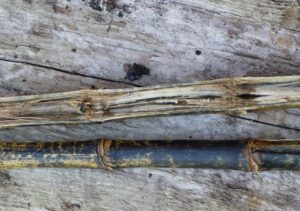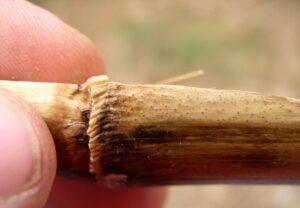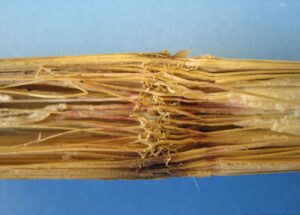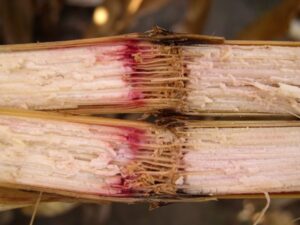Stalk Rot: A Significant Disease in Corn
Stalk rot in corn primarily leads to stalk breakage and lodging, and consequently yield loss. Stalk rot is caused by pathogens (fungi or bacteria). While abiotic stress like flooding, droughts, or insect infestations can cause similar damage, the symptoms in the stalk can vary depending on the cause.
Stalk rot pathogens attack the pith, degrading it and destroying the vascular tissue within the stalk. This disruption affects water and nutrient movement within the plant, resulting in premature plant collapse. Symptoms typically appear late in the season when lodging plants are most obvious in the field.
Diagnosis
When diagnosing stalk rot, we request submitting complete plants to the University of Illinois Plant Clinic. Multiple affected plants from random areas of the field can be submitted as a single sample. We recommend digging plants out of the ground and removing excess soil from roots by hand rather than yanking them from the soil, since root rots may accompany stalk rots, and rotted roots are often fragile and will break when tugged, remaining in the field where we cannot examine them. Each sample (can be multiple plants) should be individually labeled with the information requested on the submission report (Plant Clinic submission form). Once received, part of the sample (one or two stalks) is transversely opened (cross-sectioned) and examined under a stereoscope to identify any symptoms (reaction of the plant to infection) and signs (pathogen structures) present inside the stalk. Meanwhile, another portion of the sample is incubated in a humidity chamber for a few days to promote the growth of potential pathogens. After incubation, sections of the stalk are cut into small pieces and observed under a microscope to search for pathogen signs.
Table 1 lists common stalk rot diseases in Illinois along with diagnostic signs and symptoms. Accurate diagnosis in the field may be difficult due to multiple pathogens causing similar symptoms depending on a number of factors, including the variety of corn, stage at which the corn was infected, and environmental conditions. Stalk rot symptoms usually appear when the plants are in an advanced maturity stage, and multiple pathogens are commonly present. These pathogens include primary causes (strong pathogens that can infect healthy plants under the right environmental conditions) and secondary pathogens which usually are found on plants already damaged by other pests, pathogens, or adverse environmental stress. Cause and effect can be difficult to determine; plants already stressed by nutrient or water deficiencies may become weakened and more susceptible to infection, or the pathogens may infect the stalk first thus disrupting nutrient and water intake.
| Disease and Pathogen | Signs | Symptoms |
| Anthracnose Lower Stalk Rot (Colletotrichum graminicola) | Tufts of small dark spines may be observed with a hand lens. | Exterior nodes and internodes of corn stalks show dark, shiny discoloration. Diseased tissue is usually dark gray to brown in color (Figure 1). |
| Charcoal Rot (Macrophomina phaseolina) | Inner tissue covered in tiny black fungal bodies (sclerotia) on the vascular strands of the shredded pith (Figure 2). | Pith appears shredded and charred (darkened). |
| Stenocarpella (Diplodia) Stalk Rot (Stenocarpella maydis) | Very small dark brown to black spots (pycnidia) may develop near the nodes (Figure 3). | The lower stalk becomes spongy due to disintegrated pith and ranges in color from light to dark brown. |
| Fusarium Stalk Rot (Fusarium spp.) | Spore identification observed under the microscope. | This rot often causes root decay, with the pith turning a whitish pink to salmon coloration (Figure 4). |
| Gibberella Stalk Rot (Gibberella zeae) | Small superficial black spots (perithecia) may be visible on the stalk. These can be scrapped off with a fingernail. | The stalk interior often shows pink to reddish discoloration and shredded pith (Figure 5). |
| Pythium Stalk Rot (Pythium aphanidermatum) | Oospores or sporangia observed in the pith with a microscope. | Pith appears soft, brown, and water soaked. Leaves remain green even after lodging. Stalks twist during lodging. |
| Bacterial Stalk Rot (E. chrysanthemi pv. zeae) | Bacterial streaming observed under the microscope. | Stalk and rind show dark brown, water-soaked lesions; soft, slimy tissue with a foul odor; twists during lodging. Plant tips may become slimy and rotten, potentially leading to premature death. |
Table 1. Symptoms and signs of stalk rot diseases.
As mentioned earlier, multiple pathogens are often found in stalk samples. We identify all pathogens observed and indicate which are the most prevalent or likely to be the primary cause of the symptoms. In some cases, conclusive identification requires culturing infected tissue by placing it on sterile, nutrient-rich media in Petri dishes to allow any pathogens present to grow.
It’s impossible to completely eliminate crop stress in the field, and there is no single management practice that can fully prevent stalk rots in field corn. However, stress can be reduced through good agronomic practices and integrated pest management.
| Field Examination | Inspect the field when fully mature before the crop is harvested. |
| Crop Stress Management | Maintain optimal soil fertility and watering. Use recommended plant density by seed companies and manage insect populations such as corn borer and fall armyworm. |
| Scouting | Examine 20 stalks at each of five sites per field when scouting for stalk rot. |
| Stalk Testing | – Squeeze the base of the stalk with your hand. – Alternatively, push the stalk 8 to 10 inches from its vertical position at chest height to check for lodging. |
| Record Observations | Note the type of stalk rot and the number of plants showing symptoms. Some plants may exhibit multiple types of stalk rot; record all types present. Modern technologies, such as drones, can accurately identify areas of lodging and assist in targeted sampling. |
| Early Harvest | Schedule early harvest if 10-15% of the plants show stalk rot symptoms. Ensure quick drying of grain to prevent ear and kernel rots. |
| Prevention | To minimize future stalk rot, plant resistant varieties and hybrids. The use of fungicides can reduce the impact of foliar diseases, reducing stress and improving the physiological performance of the plant. |
Table 2. Scouting and Management recommendations

Figure 1. Anthracnose lower stalk rot symptoms. Image: Adam Sisson, Iowa State University, Bugwood.org

Figure 2. Black fungal bodies (sclerotia) of charcoal rot (Macrophomina phaseolina). Image: Jason Brock, University of Georgia, Bugwood.org

Figure 3. The black spots are pycnidia of Stenocarpella (Diplodia) stalk rot (Stenocarpella maydis). Image: Gary Munkvold, Bugwood.org

Figure 4. Characteristic whitish-pink to salmon color symptoms produced by Fusarium stalk rot (Fusarium species). Image: Alison Robertson, Bugwood.org

Figure 5. Pink internal discoloration caused by Gibberella stalk rot (Gibberella zeae). Image: Gary Munkvold, Bugwood.org
References
- University of Nebraska-Lincoln Extension
- University of Kentucky Integrated Pest Management
- Pioneer Agronomy: Managing Stalk Rot
- Crop Protection Network
Authored by Esneider Mahecha (esmabo@illinois.edu) and Diane Plewa (dpleawa@illinois.edu), University of Illinois Plant Clinic, Reviewed by Talon Becker (tbecker2@illinois.edu), University of Illinois Extension.





